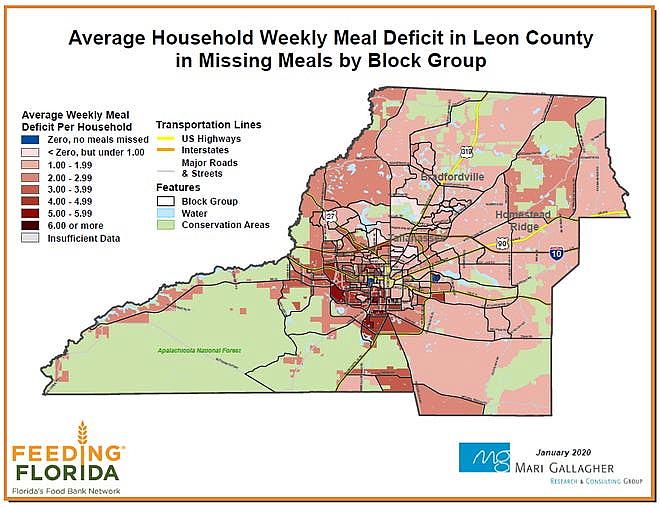13 million missed meals in Leon: 'Meal Deficit Metric' aims to track hunger across Florida
This story was produced as a project for the 2019 National Fellowship.
Other stories in this series include:
Coronavirus: Lack of access to tests hampers care in Tallahassee's poorer neighborhoods
Going granular: Why deep dives into health data can help kids in poor zip codes like 32304
At 32304's Riley Elementary, staff 'serve a greater need than just educating the mind'
'No access': Poor, isolated and forgotten, kids of 32304 see their health care compromised
Distanced from assistance: Rampant health problems in Gadsden mirror coronavirus risk factors
‘Our kids aren’t growing up’: Epidemic of gun violence scars, kills Tallahassee’s Black children
A new metric aims to be a more accurate tool for detecting missed meals and fighting hunger throughout Florida.
The Meal Deficit Metric, developed by Mari Gallagher Research & Consulting Group and commissioned by Feeding Florida, is a measure that uses several data sources to predict missed meals at the block group level — a U.S. Census-defined geography that’s much smaller than the ZIP code.
Why block groups? Granularity, lead researcher Mari Gallagher explained, provides a more accurate illustration of where the needs are.
“There is a lot of variation across counties,” Gallagher said. “We need to know exactly where the meals are missed, and these pinpointed units of measurement direct anti-hunger leaders to those families in need."
Users can fill out the form on Feeding Florida's website to access heat maps of all 67 counties in Florida and each county's "Meal Deficit Score." The darker the shading of a particular area — a block group — the higher the weekly average of meals missed per household.
According to the meal deficit scoring system, more than 13 million meals are missed annually in Leon County alone, with a rate of 5.16% missed meals, based on a countywide average of block groups.

In neighboring Gadsden County, 6.56% meals are missed — the highest rate of any county in Florida — and the average household lacks 3.44 meals per week.
The MDM calculation takes into account different ways households might acquire food, such as through subsidies like SNAP, WIC, or free or reduced meals at school. It also includes food acquired from friends, pantries, churches or other charities using U.S. Department of Agriculture's annual hunger survey, which asks participants whether and where they get help.
Instead of using an income threshold to identify who might be hungry, the metric includes households from all income levels. That includes those that might not be at the federal poverty level — but are still struggling to feed their families.
“This takes the guesswork and the stereotypes out of the war against hunger,” said Gallagher, who added that the calculations are statistically significant, or mathematically reliable.
The results from the calculations will be used by Feeding Florida's network, primarily food banks such as Second Harvest of the Big Bend, to target hunger relief efforts, said Feeding Florida's executive director Robin Safley.
She hopes the model will help food banks and state agencies look at the "food environment" of an area to strategize building infrastructure and sustainable access to food.
"Hunger is just a symptom of an under-resourced home," she said. "But this data can be a beacon, if you will, of hotspots."
See your county's 'Meal Deficit Score': Fill out the form on Feeding Florida's website, pinpointhunger.com, to access the maps.
Reach Nada Hassanein at nhassanein@tallahassee.com or on Twitter @nhassanein_.
[This article was originally published by The Tallahassee Democrat.]

